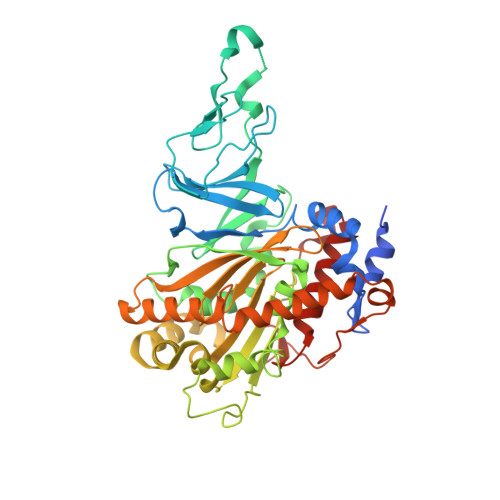Structural Basis of the Enhanced Pollutant-Degrading Capabilities of an Engineered Biphenyl Dioxygenase
Kumar, P., Dhindwal, S., Neau, D., Gomez-Gil, L., Sylvestre, M., Eltis, L.D., Bolin, J.T.(2016) J Bacteriol 198: 1499
- PubMed: 26953337
- DOI: https://doi.org/10.1128/JB.00952-15
- Primary Citation of Related Structures:
5AEU, 5AEW - PubMed Abstract:
Biphenyl dioxygenase, the first enzyme of the biphenyl catabolic pathway, is a major determinant of which polychlorinated biphenyl (PCB) congeners are metabolized by a given bacterial strain. Ongoing efforts aim to engineer BphAE, the oxygenase component of the enzyme, to efficiently transform a wider range of congeners. BphAEII9, a variant of BphAELB400 in which a seven-residue segment, (335)TFNNIRI(341), has been replaced by the corresponding segment of BphAEB356, (333)GINTIRT(339), transforms a broader range of PCB congeners than does either BphAELB400 or BphAEB356, including 2,6-dichlorobiphenyl, 3,3'-dichlorobiphenyl, 4,4'-dichlorobiphenyl, and 2,3,4'-trichlorobiphenyl. To understand the structural basis of the enhanced activity of BphAEII9, we have determined the three-dimensional structure of this variant in substrate-free and biphenyl-bound forms. Structural comparison with BphAELB400 reveals a flexible active-site mouth and a relaxed substrate binding pocket in BphAEII9 that allow it to bind different congeners and which could be responsible for the enzyme's altered specificity. Biochemical experiments revealed that BphAEII9 transformed 2,3,4'-trichlorobiphenyl and 2,2',5,5'-tetrachlorobiphenyl more efficiently than did BphAELB400 and BphAEB356 BphAEII9 also transformed the insecticide dichlorodiphenyltrichloroethane (DDT) more efficiently than did either parental enzyme (apparent kcat/Km of 2.2 ± 0.5 mM(-1) s(-1), versus 0.9 ± 0.5 mM(-1) s(-1) for BphAEB356). Studies of docking of the enzymes with these three substrates provide insight into the structural basis of the different substrate selectivities and regiospecificities of the enzymes.
Organizational Affiliation:
Department of Biotechnology, Indian Institute of Technology Roorkee, Roorkee, Uttarakhand, India.

















